#thutmose iv
Explore tagged Tumblr posts
Text
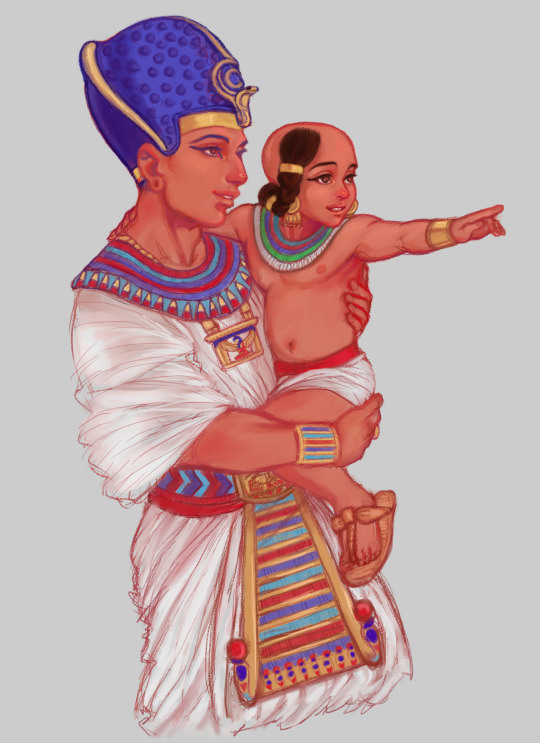
They are looking at the freshly repainted Giza Sphinx idk
#old art from 2020#thutmose iv 🥺#baby amenhotep iii 💗#old.old art#imma try to do more art this yearrrrr#ancient egypt#thutmose iv#amenhotep iii#my art
455 notes
·
View notes
Text

Mummy of Thutmose IV
Thutmose IV died young and was buried in the Valley of the Kings. Later, the mummy was moved to the Deir el-Bahari cache (“DB320”) with other royal mummies.
His body was rewrapped in its original bandages, with the feet broken off, but not lost. The king was balding. This mummy was the first of that time to have pierced ears; his fingernails were manicured. The mummy's hands were crossed on his chest, in the Osirian position.
New Kingdom, 18th Dynasty, ca. 1401-1391 BC. Now in the NMEC, Cairo. JE 34559
Read more
40 notes
·
View notes
Text
The chariot of Thutmose IV
El carro de Tutmosis IV

(English / Español / Italiano)
Deep in the Valley of the Kings, archaeologist Howard Carter discovered something extraordinary in 1903: the almost 3,400-year-old body of Thutmose IV in his tomb, KV 43. This chariot is one of the few Egyptian examples to have survived to the present day. It was part of the king's funerary objects, intended to serve him in the afterlife, and offers a rare glimpse into the past.
The chariot, made of light wood, was designed to be fast and manoeuvrable, essential for both battle and ceremonial purposes. Not only was it practical, but it was also beautifully decorated, probably with gold leaf, leather and intricate designs. These details emphasised the king's power and status, appropriate for a ruler who was both a warrior and a divine figure.
The discovery of the chariot of Thutmose IV provides valuable insight into the engineering and art of the 18th Dynasty. Despite being buried for millennia, its preservation helps us to understand the importance of chariots in ancient Egypt and shows the skill of its craftsmen.
----------------------------------------------------------------------------
En las profundidades del Valle de los Reyes, el arqueólogo Howard Carter descubrió algo extraordinario en 1903: el cuerpo de Tutmosis IV, de casi 3.400 años de antigüedad, que se encuentra en su tumba, KV 43. Este carro es uno de los pocos ejemplos egipcios que han sobrevivido hasta nuestros días. Formaba parte de los objetos funerarios del rey, destinados a servirle en el más allá, y ofrece una visión poco común del pasado.
El carro, hecho de madera ligera, fue diseñado para ser rápido y maniobrable, algo esencial tanto para la batalla como para las ceremonias. No solo era práctico, sino que también estaba bellamente decorado, probablemente con pan de oro, cuero y diseños intrincados. Estos detalles resaltaban el poder y el estatus del rey, algo apropiado para un gobernante que era a la vez un guerrero y una figura divina.
El descubrimiento del carro de Tutmosis IV nos brinda una valiosa perspectiva de la ingeniería y el arte de la XVIII Dinastía. A pesar de estar enterrado durante milenios, su conservación nos ayuda a comprender la importancia de los carros en el antiguo Egipto y muestra la habilidad de sus artesanos.
----------------------------------------------------------------------------
Nel profondo della Valle dei Re, nel 1903 l'archeologo Howard Carter scoprì qualcosa di straordinario: il corpo di Thutmose IV, risalente a quasi 3.400 anni fa, nella sua tomba KV 43. Questo carro è uno dei pochi esemplari egizi sopravvissuti fino ai giorni nostri. Faceva parte del corredo funerario del re, destinato a servirlo nell'aldilà, e offre un raro sguardo sul passato.
Il carro, realizzato in legno leggero, era progettato per essere veloce e maneggevole, essenziale sia per la battaglia che per le cerimonie. Non solo era pratico, ma era anche splendidamente decorato, probabilmente con foglie d'oro, pelle e disegni intricati. Questi dettagli sottolineavano il potere e lo status del re, appropriati per un sovrano che era sia un guerriero che una figura divina.
La scoperta del carro di Thutmose IV offre una preziosa visione dell'ingegneria e dell'arte della XVIII dinastia. Nonostante sia stato sepolto per millenni, la sua conservazione ci aiuta a capire l'importanza dei carri nell'antico Egitto e mostra l'abilità dei suoi artigiani.
Source: Diario de Historia
#ancient egypt#antiguo egipto#XVIII dinastia#18th dynasty#Thutmose IV#valle dei re#valle de los reyes#valley of the kings
11 notes
·
View notes
Text
Chariot Body of Thutmose IV

Deep in the Valley of the Kings, archaeologist Howard Carter uncovered something remarkable in 1903 — the nearly 3,400 year-old chariot body of Thutmose IV, the 8th pharaoh of the 18th Dynasty of Egypt.
Found in his tomb, KV 43, this chariot is one of the few Egyptian examples to survive into the modern day.
It was part of the king’s burial items, meant to serve him in the afterlife and offers a rare glimpse into the past.
Made from lightweight wood, the chariot was designed for speed and maneuverability, essential for both battle and ceremony.
It wasn’t just practical. It was also beautifully decorated, likely with gold leaf, leather, and intricate designs.
These details highlighted the king’s power and status, fitting for a ruler who was both a warrior and a god-like figure.
The discovery of Thutmose IV's chariot gives us a valuable look at the engineering and artistry of the 18th Dynasty.
Despite being buried for millennia, its preservation helps us understand the significance of chariots in ancient Egypt and showcases the skill of its craftsmen.
📍Egyptian Museum, Cairo
#Thutmose IV#Howard Carter#valley of the kings#KV 43#egyptian pharaoh#pharaoh#chariot#burial items#funeral#afterlife#ancient egypt#ancient civilizations#engineering#artistry#18th dynasty#Egyptian Museum#Cairo#archaeology#craftmanship
6 notes
·
View notes
Text

Ivory bracer of the 18th Dynasty pharaoh Thutmose IV. Thutmose is shown subduing an Asiatic enemy while a falcon-headed deity looks on. Artist unknown; 1397-1388 BCE. Found at Amarna*; now in the Neues Museum, Berlin. Photo credit: Osama Shukir Muhammed Amin FRCP/Wikimedia Commons.
*It is unknown how the bracer ended up at Akhenaten's capital.
#art#art history#ancient art#Egypt#Ancient Egypt#Egyptian art#Ancient Egyptian art#Egyptian religion#Ancient Egyptian religion#kemetic#Thutmose IV#18th Dynasty#New Kingdom#jewelry#jewellery#bracer#ivory#carving#Amarna#Neues Museum
112 notes
·
View notes
Text
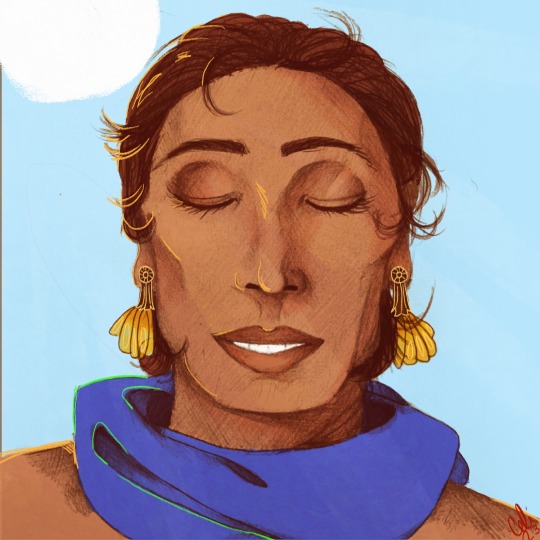
Maybe since I’ve drawn him, he’ll leave my brain and let me live.
4 notes
·
View notes
Text
Consider the Great Sphinx of Giza:
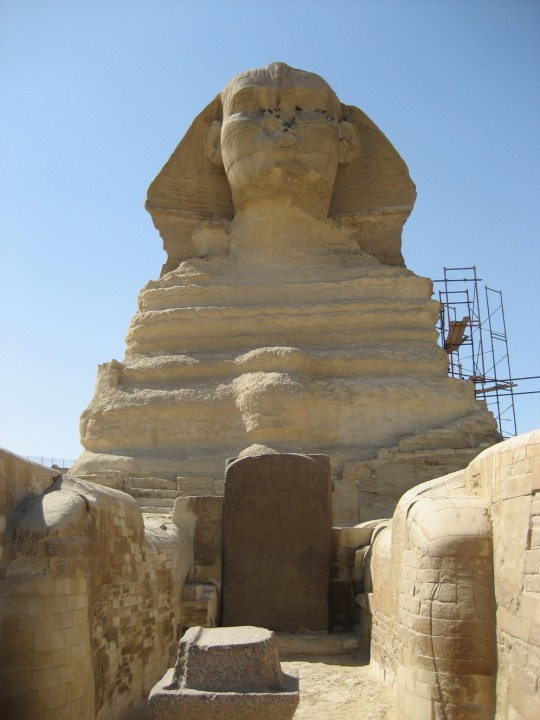
See that tablet between her legs?
It dates from 1400BC, and tells a story of how the Pharoah was told through a dream to uncover the Sphinx from the sand that buried her. So he did, made a little shrine, and added the tablet (12' high and weighing 15 tonnes). 1400BC was during the New Kingdom.
When that tablet was placed there, the Sphinx was over a thousand years old.
There's a lot of Ancient Egyptian history...
in the Egyptian wing of the museum and my boyfriend is like "what are all the time periods of ancient Egypt" and I'm like predynastic, early dynastic, old kingdom which is when the pyramids were built, first intermediate, middle kingdom, second intermediate, new kingdom which includes amarna period and yugioh, third intermediate, and then all the late period stuff and macedonian and roman eras. and he's like run that by me one more time
75K notes
·
View notes
Text
The Dream Stele: An Epigraphic Stele of Divine Kingship and Historical Intrigue in Ancient Egypt
The Dream Stele, also known as the Sphinx Stele, holds a significant place in ancient Egyptian history, particularly during the reign of the 18th Dynasty pharaoh Thutmose IV. Erected in 1401 BC, it stands as a remarkable example of an epigraphic stele, symbolizing the divine legitimization of kingship, a common practice among the rulers of the New Kingdom era. Crafted from granite, the Dream…

View On WordPress
#African History#ancient Egyptian#Ancient Egyptians#ancient egyptians history#Dream Stele#Great Sphinx of Giza#New Kingdom#pharaoh Thutmose IV#Sphinx Stele#Tanetjerians
1 note
·
View note
Photo

The Art of the Amarna Period
Of all the pharaohs who ruled ancient Egypt, there is one in particular that stands out from the rest. Over the course of his 17-year reign (1353-1336 BCE), Akhenaten spearheaded a cultural, religious, and artistic revolution that rattled the country, throwing thousands of years of tradition out the window and imposing a new world order. After his death his name was omitted from the king lists, his images desecrated and destroyed. From the surviving fragments of evidence, Egyptologists have pieced together the story of his life and reign, a period of spiritual upheaval and experimentation unlike any other in Egyptian history. Under his supervision, Egyptian art underwent a monumental transformation, with centuries of rigid convention abandoned in favor of a new, highly stylized artistic approach imbued with divine meaning.
EARLY REIGN OF AMENHOTEP IV
The second son of Pharaoh Amenhotep III, Akhenaten (originally Amenhotep IV) was never meant to be king. His elder brother, Prince Thutmose, was heir apparent, but after his untimely demise, young Amenhotep found himself thrust into the political spotlight. Following a brief period of co-regency, Amenhotep III died in 1353 BCE, and Amenhotep IV ascended to the throne. With his Great Wife Nefertiti by his side, the new pharaoh began what appeared to be a conventional reign: he dedicated monuments to Amun, added to the temple complex at Karnak, and even held a Sed festival in Regnal Year 3. However, Amenhotep IV's rule was anything but ordinary, and before long the king began to let his true colors show. The pharaoh was a fanatical devotee of Aten, a deity representing the physical form of the sun disk. Unlike most other Egyptian gods and goddesses, Aten had no human characteristics and took no anthropomorphic form. Under Amenhotep's direction, this fringe cult soon became the largest religious sect in Egypt.
In Regnal Year 5, the pharaoh dropped all pretense and declared Aten the official state deity of Egypt, directing focus and funding away from the Amun priesthood to the cult of the sun disk. He even changed his name from Amenhotep ('Amun is Satisfied') to Akhenaten ('Effective for the Aten,') and ordered the construction of a new capital city, Akhetaten ('The Horizon of Aten') in the desert. Located at the modern site of Tell el-Amarna, Akhetaten was situated between the ancient Egyptian cities of Thebes and Memphis on the east bank of the Nile.
Continue reading...
29 notes
·
View notes
Text


Egyptian
Arm Panel From a Ceremonial Chair of Thutmose IV
New Kingdom, ca. 1400-1390 B.C.E.
#Egyptian art#egyptian history#ancient egypt#ancient art#ancient people#ancient culture#egyptian culture#egyptian aesthetic#aesthetic#beauty#artifacts#antiquities#ancient artifacts#egypt#art history#tumblr art#sphinx#Egyptian sphinx#aesthetictumblr#tumblraesthetic#tumblrpic#tumblrpictures#tumblrstyle#artists on tumblr#tumblrposts
65 notes
·
View notes
Note
I bloody hate Tumblr, I didn't get to send the playlist in the ask so I'll send it again. (Assuming that you didn't get an ask about this one TT but, if I did send it... Just ignore my old ask and pretend you don't know who sent it since it was not an anon ask.)
Anyways, just wanted to say I love your fanfics (I read'em on Wattpad), especially 'Some Direction' and 'Just Like Fire'. At the moment, I'm reading 'Hat Trick' and I got hooked into in the first chapter. I haven't stopped thinking about it since work.
By the way, the playlist I made is quite mixed in terms of genre (K-pop, OPM/Original Pilipino Music, and Classical) and languages (Eng, Korean and Filipino), I hope you don't mind? Though, just in case, I noted down which is K-pop, OPM, and classical, including the language(s) they are sung in.
Sabo
- STARTAFIGHT by Joey Valence & Brae
- Hit and Run by LOLO
- What Do They Know by Mindless Self Indulgence
- I Want To Break Free by Queen
- Keep Myself Alive by Get Scared
Law & Crew
- Mary by Big Thief
- Bad Idea by Dove Cameron
- Bodies by Drowning Pool
- Barracuda by Heart
- In My Prison by IV of Spades [ OPM // ENG ]
Kid & Crew
- What's up Danger (With Black Caviar) by Blackway and Black Caviar
- PUNK! by BVDLVD ft. Lil Darkie
- Paint The Town Red by Doja Cat
- Kill Of The Night by Gin Wigmore
- Bad Reputation by Joan Jett & the Blackhearts
[ NOTE: I haven't finished Wano, I just started out, so I'm mostly basing this on my first impression during the Sabaody Arc. ]
Marco
- Under Pressure by Queen
- There Is A Light That Never Goes Out by The Smiths
- Memories by Thutmose
- It Took Me By Surprise by Maria Mena
- Familia by Nicki Minaj, Anuel AA, Bantu
Shakky
- Welcome To the Jungle by Guns N' Roses
- Captivated by IV of Spades [ OPM // ENG ]
- I Ain't Perfect by IV of Spades [ OPM // ENG ]
- Just A Girl by No Doubt
- One Woman Army by Porcelain Black
Rayleigh
- Smells like Teen Spirit by Nirvana
- Naughty Naughty by Porcelain Black
- Outta Get Me by Guns N' Roses
- Time Of My Life UPSAHL
- Egoistic by MAMAMOO [ K-pop // KOREAN ]
Kaku
- Stupid MF by Mindless Self Indulgence
- Figure It Out by Royal Blood
- Hunter or Prey by NOISEMAKER
- Revenge by (G)I-DLE [ K-pop // KOREAN BUT HAS ENGLISH ]
- Problems by Hayloft
Katakuri
- Violin Sonata in G Minor "Devil" by Giuseppe Tartini [ Classical ]
- Creep by Radiohead
- Glory and Gore by Lorde
- Are You Satisfied? by MARINA
- Misfit Lunatic by MISSIO
So I didn’t reply to this for a while because I needed time to check out the songs xD
Then I did and FORGOT TO BLOODY ANSWER THE ASK.
I liked a lot of these, my apologies for not having more detailed responses than that T-T - I’m pretty sure I added a couple and I know most of these are on my Liked list (so I can hear them again and again and see if they vibe more with time).
Thank you so much for going through and doing this with such focus \o/ it was helpful even if I apparently fever-dreamed replying >.<
Mom glad you’re enjoying the other stories \o/ and it should be obvious but I’ll say so just in case, I love all kinds of music, so there’s no disqualifications based on language ^_^ (also classical is great cause sometimes lyrics are distracting.)
7 notes
·
View notes
Text

Tombs Rich in Artifacts Discovered in Cyprus
An archaeological expedition from Sweden's University of Gothenburg has uncovered tombs rich in artifacts and antiquities in Cyprus that makes the discovery among the richest ever found in the Mediterranean region.
Peter Fischer, the leader of the expedition and a professor of archaeology at the University of Gothenburg, said “considering the richness of the grave goods, it is a reasonable assumption that these were royal tombs, even though we do not know much about the form of government practiced in the city at the time."
Fischer believes that the artifacts, found just outside the Bronze Age trading city of Hala Sultan Tekke, indicate the tombs' occupants ruled the city, which was a center for copper trade between 1500–1300 BCE. The tombs, located outside the 50-hectare city, consist of underground chambers of varying sizes, accessed via a narrow passage from the surface.
Cyprus' Department of Antiquities, in an update posted to their website, noted: "The city’s wealth seems to have been based on the production of copper and trade with near and distant cultures. Judging by the rich burial gifts, the tombs belonged to families of the city’s ruling class who took part in the export of copper and intercultural trade."
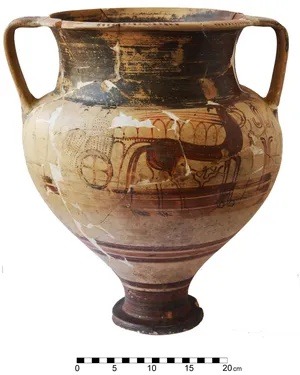
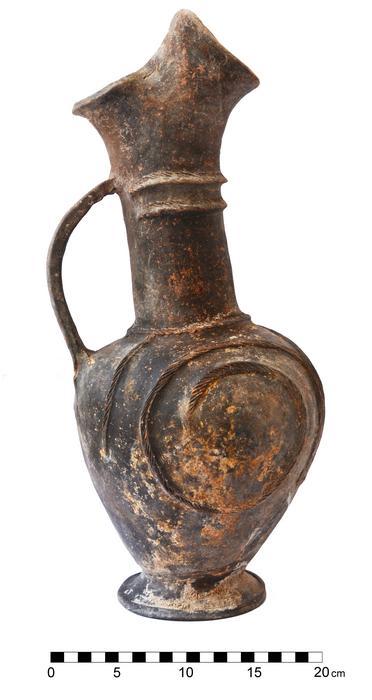
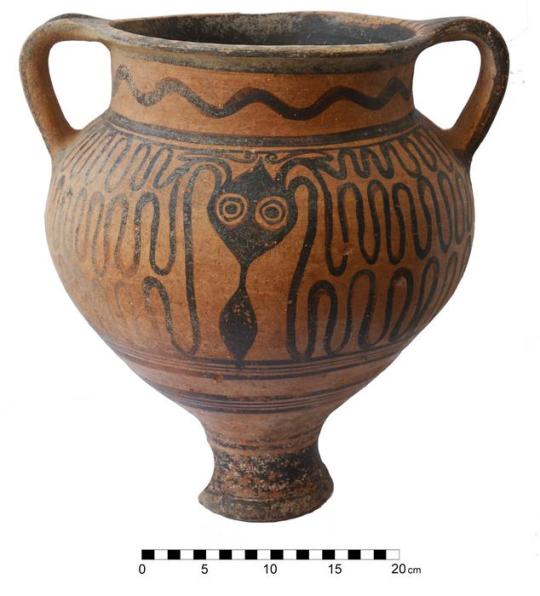
Unearthed artifacts include imports from Egypt, Baltic region
The Swedish Söderberg expedition has been carrying out excavations in Hala Sultan Tekke near the city of Larnaca on the south coast of Cyprus since 2010. Though the expedition has previously found chamber tombs with valuable grave goods, the latest discovery is unprecedented given the superb quality and quantity of artifacts.
“We found more than 500 complete artifacts distributed among two tombs. Many of the artifacts consist of precious metals, gems, ivory and high-quality ceramics," Fischer said.
About half of the artifacts unearthed during the expedition are believed to have been imported from different civilizations. For example, gold and ivory came from Egypt while precious stones, such as blue lapis lazuli, dark red carnelian and blue-green turquoise, were imported from Afghanistan, India and Sinai respectively. Amber objects from the Baltic region were also found among the artifacts.
The Department of Antiquities said that three chamber tombs, preliminarily dated to the 14th century BC, were exposed. While one of them had been looted, most likely in the 19th century AD, the other two were "undisturbed", apart from the collapse of their chambers.
Items recovered from those include locally produced pottery and ornaments and numerous items of jewelry such as diadems, which are ornamental headbands. Embossed images of bulls, gazelles, lions and flowers adorn the diadems. Bronze weapons, some inlaid with ivory, were also recovered as well as a gold-framed seal made of the hard mineral hematite with inscriptions of gods and rulers.


"Several items of ivory and faience are imports from Egypt during the famous 18th Dynasty, the time of the well-known pharaohs Thutmose III, Amenophis IV (Akhenaten) and his wife Nefertiti," said the department.
The excavation team used magnetometers, a type of instrument that can produce images showing objects and structures up to two meters beneath the surface, to carry out their expedition, according to the university.
Besides artifacts, the research team also unearthed several well-preserved skeletons in the tombs including one of a woman surrounded by dozens of ceramic vessels, jewelry and a round bronze mirror. A one-year-old child with a ceramic toy also lay beside her.
By Saman Shafiq.



#Tombs Rich in Artifacts Discovered in Cyprus#Bronze Age city of Hala Sultan Tekke#ancient tomb#chamber tombs#ancient graves#ancient artifacts#archeology#archeolgst#history#history news#ancient history#ancient culture#ancient civilizations
40 notes
·
View notes
Text

The mummified remains of King Thutmose IV (Menkheperure)
New Kingdom, 18th Dynasty The king is now at rest in the National Museum of Egyptian Civilization.
The mummy of Thutmose IV was found within the mummy cache of KV35 in 1898 by Victor Loret. The body of the king was moved in antiquity by ancient priests for safety reasons. The king was originally buried within his own tomb (KV43), which was discovered by Howard Carter in 1903.
Grafton Elliot Smith (1871-1937), upon examining the body of the king, concluded that the king was very ill at the time of death and had seemingly suffered with an illness for a while, sadly describing Thutmose IV as "extremely emaciated".
Many decades later in 2012, the Imperial College London examined the body of the late king, and along with knowledge of some of Thutmose's family dying young (such as his great-grandson Tutankhamun and his two still born daughters), the surgeon examining the king theorized that Thutmose and other members of the family may have possibly suffered with Temporal lobe epilepsy.
Some scholars think that this idea could explain the king's famous Dream Stela, where he describes the Sphinx of Giza as talking to him, as those with Temporal lobe epilepsy do suffer with visions. This idea however is a theory at the present and is not an ultimate conclusion. And it must be noted that the reason for the dream stela could have been propagandist, or simply Thutmose certifying his status as a divine ruler...such as Hatshepsut's writing of her divine birth at Deir el-Bahari. Or... it could have been something the king truly believed occurred to him, without the modern idea that he had an illness causing such a thing.
The king's body measures at 1.64m (5 ft 4.8 in), however, due to his disembodied feet, he was likely taller in life. He was relatively young, with Smith putting his age at death at approximately 28, although more modern scholars suggest mid 30s, perhaps. He has both ears pierced and what appears to be a smile with teeth showing. Most notable is his hair, which is entirely natural, long and parted in the middle, the colour is reddish brown.
Read more
65 notes
·
View notes
Text
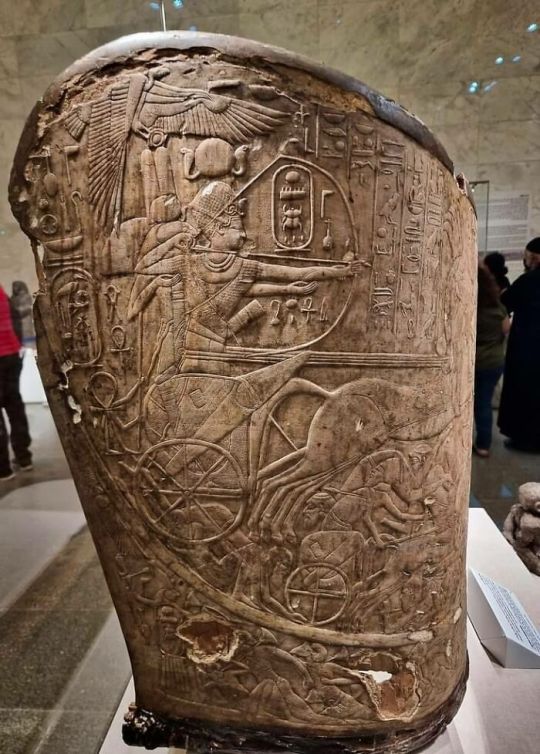
#بلادي_الجميلة ❤ #مصر ❤ The Well Preserved State Chariot Of Pharaoh Thutmose Iv (R. 1401-1388 Bc, 18th Dynasty), Showing Pharaoh Smiting His Enemies. It Was Discovered From His Tomb Kv43, Luxor, Egypt , Museum Of Egyptian Civilization, Cairo
#egypt#مصر#ancient egypt#مصريات#love#war#wars#war chariot#chariot#egyptian#Egyptian civilization#civilization#art#ancient#ancient art#ancientmonuments#ancient history#history#dynasty#thutmose#18th dynasty#life#بلادي الجميلة#museum#ancient architecture#protection#enemy#enemies#artifact#ancient artifacts
20 notes
·
View notes
Text
Shield Hero: Rise of The Four Cardinal Heroes
(I do not own Shield Hero it belongs to Aneko Yusagi)
Lizardman Slave

Race: Human (half) & Lizard Type Demi-Human (half), Gender: Male, Status: Alive, Lv: 8,
Occupation: Slave,
He is blind and radiates a strangely evil aura. He looks more human than what a lizardman should look like. After the duel, the Lizardman proclaimed his loyalty to Naofumi. Due to Naofumi's care, he gained the ability to transform into a humanoid crocodile-like form and acted like a samurai. He is worth 40 silver coins, but due to him being very skinny and suffering from a genetic disease.
//////////////////////////////////////////////////////////////////////////////////////////////////////////////
(My thoughts) I do not know who he is based on.
Name: Thutsuro.
Thut: Egyptian word for "born of Thoth" or "Thoth is born." It was a common name for Egypt's Royal family. Examples are Thutmose I, Thutmose III, & Thutmose IV. Thoth is the Egyptian god of wisdom, learning, and writing.
Suro: In Korean, this part is primarily preferred to a legendary king, known as "Kim Suro." translate to "First Dewdrop" or "Head of Dew." "Su": Head, or First, "Ro": Dewdrop.
His mother named him this because he was her wise, thoughtful, little Dewdrop.
(Also the name sounded strong despite its meaning.)
In a way, names can sound one way but mean something else, so it's important to look deeper than just the surface. For example, in my version of the lizardman, he may seem like a wicked brute, but upon closer inspection, you will find a wise, gentle soul.
#The Rising of the Shield Hero#Shield Hero#lizardman#Tate no Yuusha no Nariagari#Tate no Yuusha#rising of the shield hero
2 notes
·
View notes
Text

• Amenhotep III, also known as Amenhotep The Magnificent was the 9th pharaoh of the 18th Dynasty. According to different authors, he ruled Egypt from 1386 to 1349 BCE after his father Thutmose IV died. Amenhotep III was the son of Thutmose by a minor wife Mutemwiya.•
4 notes
·
View notes